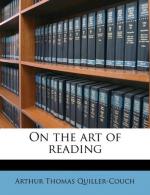(3) Then we go back and compare this kind of quiet immortal beauty with the passionate immortality hymned in the “Nightingale Ode”
Thou wast not born for
death, immortal Bird!
No hungry generations
tread thee down...
with all the rest of that supreme stanza: from which (with some passages my reading supplies to illustrate the difference) we fall to contrasting the vibrating thrill of the “Nightingale” with the happy grace of the “Grecian Urn” and, allowing each to be appropriate, dispute for a while, perhaps, over the merits of classical calm and romantic thrill.
(4) From this we proceed to examine the Ode in detail line by line: which examination brings up a whole crowd of questions, such as
(a) We have a thought enounced in the first stanza. Does the Ode go on to develop and amplify it, as an Ode should? Or does Pegasus come down again and again on the prints from which he took off? If he do this, and the action of the Ode be dead and unprogressive, is the defect covered by beauty of language? Can such defect ever be so covered?
(b) Lines 15 and 16 anticipate lines 21-24, which are saying the same thing and getting no forwarder.
(c) We come to the lines
What little town by
river or sea shore,
Or mountain-built
with peaceful citadel,
Is emptied of this folk,
this pious morn?
with the answering lines
And, little town, thy
streets for evermore
Will silent
be; and not a soul to tell
Why thou art desolate,
can e’er return.
and we note Sir Sidney Colvin’s suggestion that this breaks in upon an arrest of art as though it were an arrest on reality: and remember that he raised a somewhat similar question over “The Nightingale”; and comparing them, discuss truth of emotion against truth of reality.
We come to the last stanza and lament ’O Attic shape! Fair attitude’ for its jingle: but note how the poet recovers himself and brings the whole to a grand close.
I have, even yet, mentioned but a few of the points. For one, I have omitted its most beautiful vowel-play, on which teacher and pupil can dwell and learn together. And heaven forbid that as a teacher I should insist even on half of those I have indicated. A teacher, as I hold, should watch for what his pupil divines of his own accord; but if, trafficking with works of inspiration, he have no gift to catch that inspiration nor power to pass it on, then I say ’Heaven help him! but he has no valid right on earth to be in the business.’
And if a teacher have all these chances of teaching—mind you, of accurate teaching—supplied him by a single Ode of Keats, do you suppose we cannot set in an Examination paper one intelligent question upon it, in its own lawful category?
Gentlemen, with the most scrupulous tenderness for aged and even decrepit interests, we have been trying to liberate you from certain old bad superstitions and silently laying the stones of a new School of English, which we believe to be worthy even of Cambridge.




